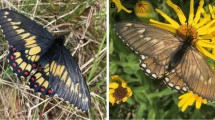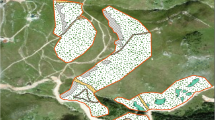Summary
I compared the differences in the movement intensity of three species of sympatricAthalia sawflies,A. japonica, A. rosae andA. infumata feeding on cruciferous plants. Mark-release-recapture census was conducted to estimate movement distance, sex ratio and age composition of adult sawflies. In addition, the sex ratio of newlyemerged adults was examined by rearing field-collected larvae until adult emergence. Age composition and longevity of adults were estimated experimentally. The movement intensity was evaluated mostly with the indirect information thus obtained.
Females moved more actively than males in all three sawflies.A. japonica females of all age classes moved actively in spring and autumn, but in summer they disappeared. Also,A. rosae females of all age classes moved actively in spring and autumn. In summer, in contrast withA. japonica, A. rosae females moved most actively among the three species in all seasons.A. infumata females, in particular the young females, moved most actively among the three species, exceptA rosae in summer.
The movement patterns of the three sawflies were deduced in relation to the spatio-temporal distributions of their habitats. In spring and autumn, when host plants were abundant,A. japonica andA. rosae females were dispersed among the host patches within the census are. In summer, however, when host plants were scarce,A. japonica entered diapause, whereasA. rosae migrated to neighboring areas. On the other hand,A. infumata, in particular young famale, innately dispersed to seek for temporary host plants throughout the census seasons.
Similar content being viewed by others
References
Abe, M. (1988) A biosystematic study of the genus Athalia leach of Japan (Hymenoptera: Thenthredinidae).ESAKIA 26: 91–131.
Baker, R. R. (1969) The evolution of migratory habit in butterflies.J. Anim. Ecol. 38: 703–746.
Benson, R. B. (1962) A revision of theAthaliini (Hymenoptera: Thenthredinidae).Bull. Brit. Mus. (Nat. Hist.) Ent. 11(7): 335–382.
Dingle, H. (ed) (1978)Evolution of insect migration and diapause. Springer-Verlag. Berlin.
Hassell, M. P. and T. R. E. Southwood (1978) Foraging strategies of insects.Ann. Rev. Ecol. Syst. 9: 75–98.
Ito, Y. (1960) Ecological studies on population increase and habitat segregation among barley aphids.Bull. Natl. Inst. Agric. Sci. C11: 45–130.
Iwao, S. (1971) Dynamics of numbers of a phytophagous lady-beetle,Epilachna vigintioctomaculata, living in patchily distributed habitats. 129–147. In Den Boer, P. J. and G. R. Gradwell (eds)Dynamics of populations. Proc. Adv. Study Inst. on ‘Dynamics of numbers in populations’. Pudoc, Wageningen.
Jolly, G. M. (1965) Explicit estimates from capture-recapture data with both death and immigration-stochastic model.Biometrika 52: 225–247.
Kishimoto, R. (1976) Synoptic weather conditions inducing long-distance immigration of planthoppers,Sogatella furcifera Horvath andNilaparvata lugens Stål.Ecol. Entomol.,1: 95–109.
Kuno, E. (1968) Studies on the population dynamics of rice leafhoppers in a paddy field.Bull. the Kyushu Agricultural Experiment Station 14: 131–246. (In Japanese with English summary)
Morisita, M. (1950) Study of the relationship between density and migration of a waterstriderGerris lacustris Linne.Studies of Physiology and Ecology in Kyoto University 65: 1–149. (In Japanese)
Nagasaka, K. (1991) Crucial factors determining the spatio-temporal distribution patterns of threeAthalia sawflies feeding on common cruciferous plants.Res. Popul. Ecol. 33: 115–128.
Naito, T. (1989) Biology ofAthalia sawflies 1.Iden 43(1): 80–85. (In Japanese)
Nakamura, K. and T. Ohgushi (1981) Studies on the population dynamics of a thistle-feeding lady beetle,Henosepilachina pustulosa (Kono) in a cool temperate climax forest. II. Life tables, key-factor analysis, and detection of regulatory mechanisms.Res. Popul. Ecol. 23: 210–231.
Nishida R. and Y. Joki (1989) Biology ofAthalia sawflies 4.Iden 43(4): 96–100. (In Japanese)
Ohsaki, N. (1980) Comparative population studies of threePieris butterflies,P. rapae, P. melete andP. napi, living in the same area. II. Utilization of patchy habitats by adults through migratory and nonmigratory movements.Res. Popul. Ecol.,22: 163–183.
Seber, G. A. F. (1962) The multi-sample single recapture census.Biometrika,49: 339–349.
Southwood, T. R. E. (1977) Habitat, the templet for ecological strategies?J. Anim. Ecol. 46: 337–365.
Waloff, Z. (1972) Orientation of flying locusts (Schistoceraca gregaria Forsk.) in migrating swarms.Bull. Entmol. Res. 62: 1–72.
Author information
Authors and Affiliations
Rights and permissions
About this article
Cite this article
Nagasaka, K. Movement patterns of threeAthalia sawflies in relation to the spatio-temporal distributions of their habitats. Res Popul Ecol 34, 1–14 (1992). https://doi.org/10.1007/BF02513518
Issue Date:
DOI: https://doi.org/10.1007/BF02513518




